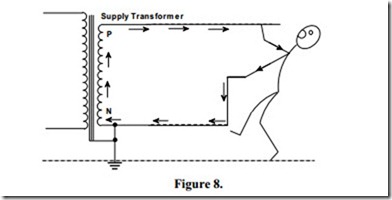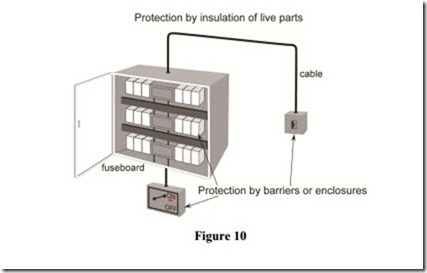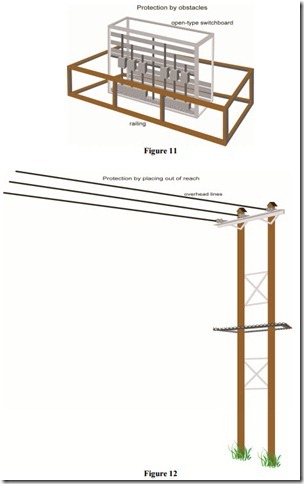Protection Against Direct Contact
Direct Contact
Direct contact is the contact of persons or livestock with live parts.
Electric shocks of this nature, occur when two parts of the body come into contact with conductors at different potentials.
Electric shock can be received in two ways:
· Figure 8 illustrates a shock between phase and neutral owing to touching both conductors at the same time. Since both conductors are insulated and protected, such shocks are usually suffered by those foolish enough to tamper with live installations.
· Figure 9 illustrates a shock from the phase conductor to earth. Because of its insulation and protection, the phase conductor normally cannot be touched, but accidents do happen. A not uncommon example is when a child manages to push a metal object into the live terminal of a damaged wall socket.
Electricians may accidentally suffer electric shock or even electrocution as described in either case above.
Clearly, it is not satisfactory to have live parts accessible to touch by persons or livestock.
The ETCI Rules recommend five ways of minimising this danger, these are listed below and three of them are illustrated in Figures 10, 11 and 12.
· By covering the live part or parts with insulation which can only be removed by destruction e.g. cable insulation.
· By placing the live part or parts behind a barrier or inside an enclosure providing protection to at least IP2X. In most cases, during the life of an installation it becomes necessary to open an enclosure or remove a barrier. Under these circumstances, this action should only be possible by the use of a key or tool, e.g. by using a screwdriver to open a joint box. Alternatively access should only be gained after the supply to the live parts has been disconnected e.g. by isolation on the front of a control panel where the cover cannot be removed until the isolator is in the ‘off’ position. An intermediate barrier of at least IP2X will give protection when an enclosure is opened: a good example of this is the barrier inside distribution fuse boards, preventing accidental contact with live parts.
· By placing obstacles to prevent unintentional approach to or contact with live parts. This method must only be used where skilled persons are working.
· By placing out of arms reach, for example, the high level of the bare conductors of travelling cranes.
· By using an RCD. Whilst not permitted as the sole means of protection, this is considered to reduce the risk associated with direct contact, provided that one of the other methods just
mentioned is applied, and that the RCD has a rated operating current of not more than 30 mA.
Related posts:
Incoming search terms:
- methods of protection against direct contact
- wiring-methods
- protection against direct contact
- what are protection against direct contact
- out of reach place for electrical protection
- methods used for preventing electric shock direct contact
- methods of protection against direct contact with live parts
- method of protection against indirect contact
- method of protection against direct cotact
- Electrical Parts supply -B2B -Marketplace -leads -platform -connecting -buyers -China -Chinese - cn -forum -shop -store -blog -wiki -dictionary -youtube - edu - gov -yellowpage -data -pages inanchor:contact
- cable machinery supply -B2B -Marketplace -leads -platform -connecting -buyers -China -Chinese - cn -forum -shop -store -blog -wiki -dictionary -youtube - edu - gov -yellowpage -data -pages inanchor:contact



